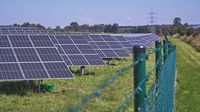On August 15, 2025, the U.S. Treasury Department shook up the renewable energy landscape by announcing stricter rules for how solar and wind projects can qualify for federal tax subsidies. These new regulations, prompted by an executive order from President Donald Trump last month, are set to have far-reaching effects on the solar and wind industries across America and beyond. The move comes at a time when the world is witnessing record-breaking investment and innovation in renewable energy, with solar power leading the charge in both cost reductions and adoption rates.
Under the new Treasury guidelines, developers of large-scale solar arrays and wind farms will have to do more than just invest capital or secure permits to qualify for lucrative federal tax credits. Instead, they must demonstrate substantial and continuous physical work on their projects. This marks a significant departure from the previous decade-long standard, where developers could “safe harbor” projects for up to four years simply by incurring 5% of the total costs before the credit expired or was reduced in value. Now, only small projects under 1.5 megawatts can still use this 5% safe harbor provision—a move seen as a positive for the residential solar sector, according to Reuters.
To qualify for the full 30% tax credit and potential bonuses under the One Big Beautiful Bill Act, projects must begin construction by July 2026 or enter service by the end of 2027. For projects starting construction as of September 2, 2025, the bar is higher: they must show ongoing, substantial physical work to remain eligible. Activities like permitting, design, or holding components in inventory no longer count as “substantial” work, according to agency documents.
The solar industry was quick to voice its concerns. Abigail Ross Hopper, CEO of the Solar Energy Industries Association, called the move “yet another act of energy subtraction from the Trump administration that will further delay the buildout of affordable, reliable power.” She added, “American families and businesses will pay more for electricity as a result of this action, and China will continue to outpace us in the race for electricity to power AI.”
This regulatory tightening comes amid a backdrop of extraordinary global momentum for solar energy. According to a new MIT study published in PLOS ONE on August 16, 2025, the price of solar panels has plummeted by more than 99% since the 1970s, transforming what was once a costly technology into the world’s cheapest form of electricity. The study traced 81 distinct innovations that have driven down photovoltaic (PV) system costs, from wire-sawing silicon blocks to faster permitting procedures and knowledge spillovers from industries like semiconductors, metalworking, and glassmaking.
“The story of how solar became the cheapest form of electricity in history, in the words of the International Energy Agency, is one of a steady pace of systemic incremental innovations that brought new materials, tools and processes, often combining these elements to improve efficiency and reduce costs,” explained Kostantsa Rangelova, global electricity analyst at energy think tank Ember, as reported by Euronews. These incremental improvements, amplified by economies of scale and “learning-by-doing,” have helped solar outpace even offshore wind, which is now 53% cheaper than fossil fuels.
The impact of these cost cuts is now visible in Europe’s power mix. In June 2025, solar power generated more electricity than any other source in the EU for the first time ever—a symbolic milestone reflecting the continent’s surging clean energy investment. In 2024, global investment in renewables reached €1.7 trillion, outpacing fossil fuel investment by €685 billion.
But the solar revolution is not without its challenges. As installations soar, scientists are turning their attention to the looming issue of end-of-life management for solar panels, which are built to last 30 years or more but are difficult to dismantle and recycle. New research projects in the EU and Australia are developing more affordable and sustainable recycling methods, and some companies are designing panels with easier recovery in mind. Repair and reuse are also gaining traction, keeping older panels in service and out of landfills.
MIT researchers argue that the next phase of cost reductions for solar may come from unexpected quarters: AI-driven design tools, robotics for faster installation, and better integration with electricity grid management. “In terms of knowledge spillovers, what we’ve seen so far in PV may really just be the beginning,” said study co-author Magdalena Klemun. Modularity—designing panels as smaller, standardized parts—has already contributed to rapid cost reductions in battery technologies, suggesting further gains are possible.
Meanwhile, in Western Australia, the promise and pitfalls of solar’s next chapter are playing out in real time. On August 16, 2025, research commissioned by the WA Greens leader Brad Pettitt revealed that only 13% of the rooftop solar potential in the state’s main grid has been realized. With about 400,000 small-scale solar customers—fewer than 5% of whom have home batteries—the report argues that fully utilizing rooftop solar and home batteries could halve the need for new high-voltage power lines and reduce reliance on large-scale wind and solar farms.
Households like Suzanne Bradshaw and Greg Ash have invested over $20,000 in solar panels and batteries to power their home and Ash’s glass furnaces. “The good thing about that is if it’s an overcast day and you’re not getting as much solar coming in, you can top up your battery during the middle of the day,” Bradshaw told ABC News. “That also means we’re not using electricity during the peak… that other consumers need.”
The Western Australian government insists its clean energy plan is on track, with subsidies to improve access to small-scale solar. Energy Minister Amber-Jade Sanderson noted that up to 100,000 households are being helped to get batteries through a subsidy scheme. Yet, critics warn that large-scale projects benefit from economies of scale, and that households risk overcapitalizing on solar and batteries. Greg Watkinson, former CEO of WA’s economic watchdog, cautioned, “The risk is that households end up spending too much. If we ended up having solar panels on everyone’s roofs, maybe we’d be spending too much. I expect we would be, so I don’t think that’s the way to go.”
As Western Australia races to exit coal power by 2029, the debate over the best path forward—large-scale projects versus small-scale, distributed solutions—echoes the broader global conversation. The lessons from MIT’s retrospective analysis are clear: breakthroughs often come from unexpected places, and sustaining the conditions that allowed for past innovation is crucial for future progress. Whether through smarter policies, new technologies, or simply making better use of what’s already available, the race for affordable, reliable, and sustainable energy is far from over.
With regulatory winds shifting and innovation accelerating, the world’s energy future hangs in a delicate balance—one where every rooftop, every battery, and every policy decision could tip the scales.




